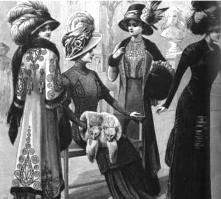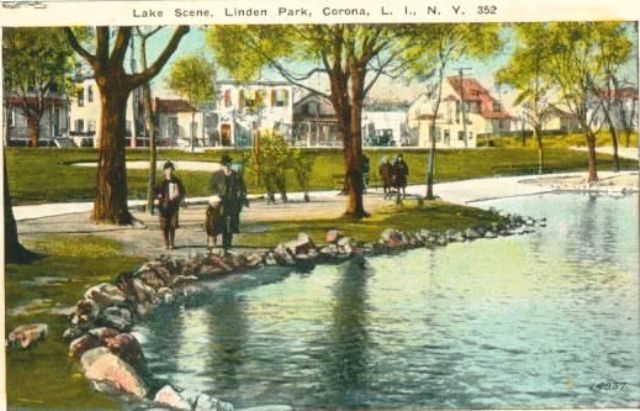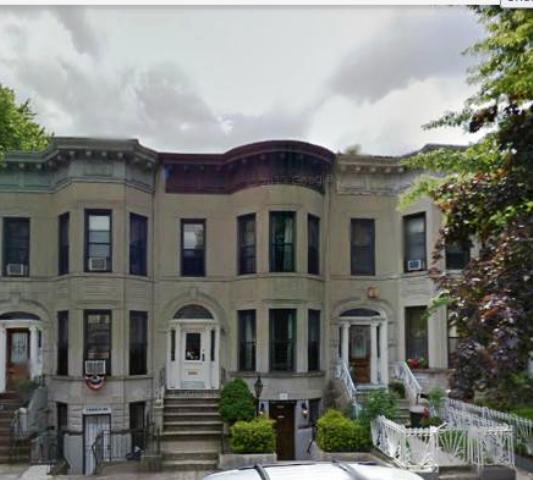“If, as the Arabs suppose, the spirits of gentlewomen are re-embodied in cats, there is a delicate appropriateness in this dedication of cat fur to the adornment of living gentlewomen.” –The New York Times, October 12, 1890

“What Smart Women Are Wearing”
In the 1800s and early 1900s, furs were all the rage in Paris and, thus, among the ladies of high society in New York City. In an article titled “Facts About Furs,” published in The New York Times on October 12, 1890, it was reported that the furs of skunks, cats, and dogs were gaining in popularity among the furriers in the United States because they were both durable and comparatively cheap.
 If it was fashionable in Paris, it was a fashion must in New York. Extravagant hats with ostrich feathers and outrageous fur muffs and shawls were in high style in the 1800s.[/caption]
If it was fashionable in Paris, it was a fashion must in New York. Extravagant hats with ostrich feathers and outrageous fur muffs and shawls were in high style in the 1800s.[/caption]
Dog fur, the article noted, was valuable to furriers who wanted to “place aristocratic furs within reach of the democratic masses.” Sheared, plucked and dyed, the fur of the average yellow dog “could be converted into so good an imitation of
sea otter that only experts may distinguish it.”
Cat furs from both small wild cats and domesticated felines were also gaining in popularity, as the furriers learned to make cat skins look like “almost any kind of fur except seal, otter, beaver, sable, or mink.” It was noted that a very fine fox-skin muff could be made of cat fur. With native cat skins selling at $1.50 and $2.00, the reporter said, “Trappers and hunters might find profitable employment in the city back yards as well as the northern wilds.”
A Catastrophic Plan
About 21 years after this article was published, a group of residents from Corona, Queens, got together in December 1911 to devise a way to get rich off of stray cats. Recognizing that cat skins made “excellent coat liners” and would thus be in high demand, the group proposed to open a cat farm that would operate very similar to a poultry farm.
On December 22, the residents met at the hotel of Henry Glickman, 102 National Avenue at Spruce Street (near today’s 103rd Street and Roosevelt Avenue). At the meeting, the group discussed purchasing a plot of land on Long Island and starting a business called the Corona Cat Skin Company.

Henry Glickman’s hotel was located near the old Linden Lake in Corona. The lake was bounded by Sycamore St. (now 104th St.), Park St. (now 42nd Ave.), Linden St. and National Ave. (now 103rd St.), and Lake St. (now 41st Ave). After WWII, the lake was deemed unsanitary, so it was filled in. Today it is a NYC park called the Park of the Americas.
The plan was to let the public know that they wanted stray cats, and to advise any young boys who lived within a “reasonable freight-weight radius” to start grooming these stray cats in preparation for the new cat farm. (I wonder if they intended on having the cats shipped to them…)
Mr. Glickman and his gang also proposed to fatten the cats by feeding rats to them, and said they would encourage rat catchers to bring their vermin to the cat farm.
“Liberal prices would be paid,” the press reported, although prices had not been set for different breeds and colors of cats. Once the company had enough strays, it would then operate its own breeding program. (Is anyone else getting an image of Cruella de Vil right about now?)
Cat Farm Would Cater to Furriers
One furrier interviewed by The Times said there would be a big market for a cat skin industry. In fact, he thought the supply of cats could never meet the demand. Here’s what I. Freundlich of I. Freundlich & Sons (14-18 East 32nd Street, Manhattan) told the reporter:
“New York gets a great number of cat skins from men in the West who make a business of catching cats and skinning them. I don’t know of any cat-breeding institutions, but they would certainly pay if they furnished the goods. Cat skins would make elegant automobile coats, for instance, and they are used for that purpose now. I have had many skins shipped here for persons who prefer cat skins. The most desirable skins are those of the Maltese cat, the ordinary all gray house cat. These skins sell for 50 to 75 cents. The black cat skins, of course, are less desirable, selling for 25 to 40 cents per skin. I would not be surprised to see such industries flourish in the future.”

Henry Bergh founded the American Society for the Prevention of Cruelty to Animals (ASPCA) on April 10, 1866.
The SPCA Has a Kitten!
We didn’t have PETA back then, but I’m happy to report that Henry Bergh and his Society for the Prevention of Cruelty to Animals (SPCA) was not pleased with this news, and publicly announced that it was a cruel idea.
“I do not think the object obtained by the killing of cats wholesale would be justifiable,” said Bergh, who was then treasurer of the society and a member of its Board of Managers. “I doubt whether it would be justifiable to kills cats under any considerations unless the flesh of the animal be used as food…The Society for the Prevention of Cruelty to Animals will certainly investigate such an institution if it becomes effective.”
In response to Bergh’s statement, the promoters of the cat farm replied that they did not intend to skin the cats alive. They also said they would treat the cats very well — after all, the cats would have to be treated well if they were to bear smooth coats. (How thoughtful of them.) Mr. Glickman also said that “moonlight soirees on back fences will not be tolerated” because such disturbances would not be good for the pelts.
More Fur Flying
At about the same time the Corona group was making plans, a group from Bay Ridge, Brooklyn, led by Johann Gustave Grafenstein of 450 75th Street, was also considering opening a cat farm on Long Island. Gus had apparently visited a cat farm in Russia, where a furrier was raising cats and then killing them for their furs. (Oh, this is a horrible story.) Ironically, Gus had just retired and sold his business on 52nd Street and 5th Avenue — Dairymen’s Milk Co., which was engaged in the production, bottling, and selling of milk and cream.
Gus told some friends about the idea, “who thought highly of the scheme.” Their plan was to purchase a lot about a half-acre square and then construct a concrete wall around the farm that would go six feet into the ground so that the cats couldn’t dig themselves out.
Cat Got Their Tongues

Gus Grafentstein never did open a cat farm on Long Island. He died in 1916 when he fell down the stairs at his home at 450 75th Street in Brooklyn, shown here.
In May 1912, Henry Glickman told the Brooklyn Daily Eagle that the company planned to start its cat business on a large scale within a few weeks. However, there appears to be no further discussion of the cat farm and no action taken. Henry Glickman sold his hotel at 102 National Avenue in 1914, and the next time he appeared in the newspaper it was to announce his plans to build a large meeting hall on Poplar Street to be used by various organizations.
As for Gus, he died tragically and suddenly at the age of 53 on November 11, 1916. He apparently broke his neck when he fainted in his home and fell down a flight of stairs. Justice can been sweet sometimes.
Unfortunately, quite a few cat farms really did exist in upstate New York and throughout the country in the late 1800s and early 1900s. Let’s just all hope this fashion trend never comes back in style.




Reblogged this on round the watertrough.
[…] 1911: The Corona Cat Farm of Queens That Wasn’t […]